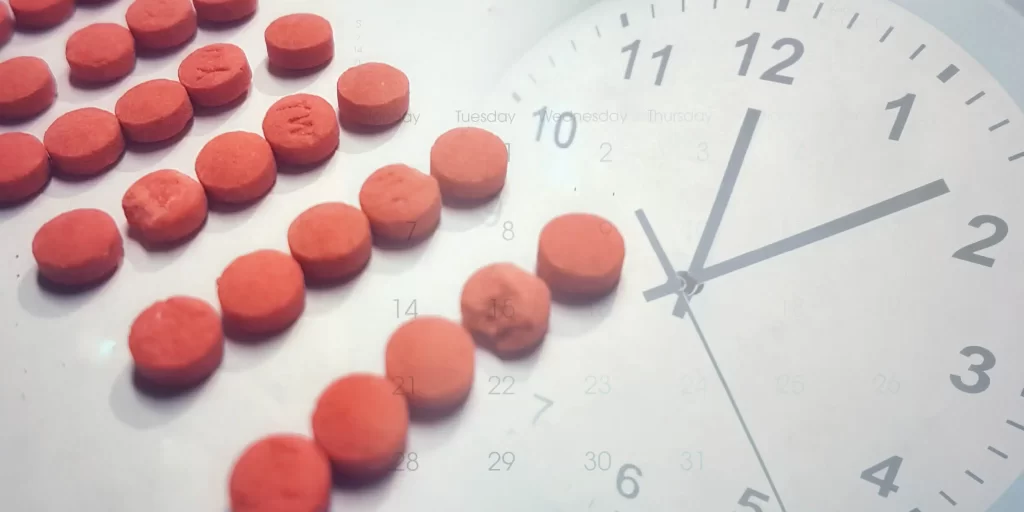How Long Do Amphetamines Stay in Your System?
Written by Theresa Valenzky
& Medically Reviewed by Benjamin Caleb Williams, RN
Medically Reviewed
Up to Date
Last Updated - 6/17/2022
View our editorial policy
Amphetamines refer to a small group of central nervous system (CNS) stimulants drugs. They stay in the body anywhere from one to several days based on the type of amphetamine used. Commonly used amphetamines include:
- Adderall (and other amphetamine salts)
- Dexedrine (Dextroamphetamine)
- Vyvanse (Lisdexamfetamine))
- Methamphetamine (Desoxyn)
When people talk about amphetamines, they may be referring to an illicit amphetamine like meth or prescription stimulants like Adderall, Vyvanse or Dexedrine. Knowing the difference can help you better understand how long amphetamines stay in your system.
What Are Amphetamines?
Amphetamines are a type of drug classified as a stimulant. These drugs increase the body’s normal functions and the speed at which the brain sends and receives messages. Amphetamines are used medically to treat attention-deficit/hyperactivity disorder (ADHD) or narcolepsy. Their stimulating effect may, however, cause them to be used to get high or improve one’s mood.
How Are Amphetamines Metabolized in the Body?
The liver breaks down amphetamines, but some of the drug is filtered into the urine by the kidneys. There is no way to flush amphetamines or other drugs out of the body quickly. It takes time to break down amphetamines.
How Long Does it Take for Amphetamines to Kick In?
The length of time it takes for amphetamines to kick in depends on the specific drug and their method of use. When slowed in pill or tablet form, they will typically take about half an hour to begin to take effect, as they must first be absorbed in the intestines. When injected or snorted, amphetamines kick in much faster, generally within a few minutes.
How Long Do Amphetamines Last?
The effects of amphetamines can last different time lengths depending on the drug used. The effects of amphetamines typically last for about four to six hours. However, some prescription formulations last much longer. For example, Adderall XR (extended-release) contains beads that slowly release the active ingredient over 8–12 hours.
Vyvanse works for about 8–12 hours but has unique pharmacology. The molecule is dextroamphetamine attached to the amino acid lysine. When Vyvanse enters the body, proteins in the blood cleave off the lysine molecule and leave active dextroamphetamine.
Methamphetamine causes peak effects within a few hours after use and can last between 8–12 hours for most people, regardless of the administration method.
Amphetamines Half-Life
A drug’s half-life is how long it takes the body to remove half of a dose. For example, a person taking 10 mg of dextroamphetamine will still have 5 mg in their body 12 hours later, 2.5 mg 24 hours later and so on. A drug’s half-life is almost always longer than the duration of its effects. Drugs tend to stay in the body long after their effects have worn off.
Half-lives for common amphetamines are:
- Amphetamine Salts: 10–13 hours
- Dextroamphetamine: 12 hours
- Vyvanse (lisdexamfetamine): one hour, then 12 hours once converted to dextroamphetamine in the body
- Methamphetamine: 10 hours
Vyvanse has two half-lives because it must be converted to its active ingredient, dextroamphetamine, in the body. When someone takes Vyvanse, it takes five hours to convert to dextroamphetamine fully, and the body begins metabolizing dextroamphetamine before all Vyvanse is converted to dextroamphetamine.
Methamphetamine’s half-life is about 10 hours, so it generally stays in the blood for 50 hours. However, it may remain in some body tissues far longer, not completely eliminated for 120 hours.
How Long Do Amphetamines Stay in Your System?
How long amphetamines affect you depends on the dose and the way they are used; however, they typically affect you for up to 12 hours. While they are unlikely to affect you beyond 12 hours, they may still be detected for much longer.
How Long Does Amphetamine Stay in Urine?
Amphetamine salts can be detected in the urine for three days after a single use. People who take amphetamines daily will typically test positive for nine days after the last dose. Methamphetamine is detectable for longer than amphetamines and can be detected for up to seven days in the urine after just one dose.
How Long Does Amphetamine Stay in Blood?
Amphetamine salts and dextroamphetamine stay in the blood for about 60 hours. This time depends on the dosage used and how quickly your body can metabolize the drugs. Amphetamines may be detectable for even longer in those with slower metabolisms.
How Long Does Amphetamine Stay in Hair?
Amphetamines can be detected the longest in hair. Hair drug tests are effective because when a drug is used, it enters hair follicles and ends up in the hair’s growing strand. Because the drug remains in the hair, amphetamines can be detected in hair for 90–180 days after being used.
How Long Does Amphetamine Stay in Saliva?
Amphetamine is measurable in the saliva for the same amount of time it is in the blood, roughly 60 hours. Methamphetamine is measurable for 55 hours in the saliva.
Factors Affecting How Long Amphetamines Stay in Your System
The amount and frequency of amphetamine use will be the primary factors affecting how long it stays in the body.
Genetics plays a role as well, but the effects are not predictable. Some modifiable factors that affect how long amphetamines stay in the body include:
- Amount used: The more a person uses, the longer it is detectable in a drug test.
- Frequency of use: Taking amphetamines every day will cause the dose to accumulate and stay in the body longer.
- Method of use: The method by which a person uses amphetamines does not play a significant role in how long they stay in the system, but it does have a slight impact.
- Age: In general, older people will metabolize drugs more slowly because their liver and kidneys lose function over time. Amphetamines may last a little longer in older patients.
- Overall health: The liver mostly metabolizes amphetamines, so people with liver problems will metabolize them more slowly.
False Positives for Amphetamines
Urine drug screens are prone to error, especially when looking for amphetamines. False positives happen because amphetamines have simple chemical structures, and many other drugs have a similar shape. Urine drug screens can accidentally report false positives for these drugs by mistake:
- Antidepressants (selegiline, bupropion, trazodone, fluoxetine, tricyclics antidepressants)
- Antihistamines (chlorpheniramine, brompheniramine, pheniramine)
- Antipsychotics (chlorpromazine, thioridazine)
- Labetalol
- Phentermine
- Phenylephrine
- Promethazine
- Pseudoephedrine
- Ranitidine
A positive result will be sent to another lab for confirmation. The confirmation test, called liquid chromatography-mass spectrometry (LC-MS), is very sensitive and specific. In other words, LC-MS tests are not prone to false positives like standard urine drug screens.
Error: Contact form not found.
How to Get Amphetamines Out of Your System
Unlike opioids and benzos, there are no antidotes or reversal agents for amphetamines. This means there is no quick and easy way to reverse their effects. Ultimately, your body must process amphetamines and get them out of your system by itself.
There may be ways to optimize how well your body metabolizes amphetamines, but the effects this will have is unlikely to be significant. Some ways to improve how quickly your body metabolizes amphetamines include:
- Staying well hydrated
- Avoiding using medications or alcohol
- Exercising
- Only eating nutritious, healthy foods
You can get rid of amphetamines as fast as possible by staying active and healthy while also reducing the workload on your liver.
Finding Help for Amphetamine Addiction in Washington
The Recovery Village Ridgefield provides state-of-the-art amphetamine addiction treatment that includes both medical detox to support you during withdrawal and rehab treatment to help you maintain newly-achieved sobriety. Our goal is to keep you as safe and comfortable as possible and help you overcome addiction successfully.
Amphetamine addiction can be dangerous and hard to overcome. If you or a loved one is addicted to amphetamines, you should consider seeking professional help. Contact us today to learn more about how we can help you achieve lasting recovery.
Sources
View Sources
Cone, Edward J.; Huestis, Marilyn A. “Interpretation of Oral Fluid Tests for Drugs of Abuse.” Annals of the New York Academy of Sciences, March 1, 2007. Accessed July 30, 2019. Cruickshank, Christopher C., and Kyle R. Dyer. “A Review of the Clinical Pharmacology of Methamphetamine.” Addiction, 2009. Accessed Aug 19, 2019. Moeller, Karen E.; et al. “Urine Drug Screening: Practical Guide for Clinicians.” Mayo Clinic Proceedings, January 2008. Accessed July 30, 2019. U.S. National Library of Medicine. “Amphetamine Sulfate.” 2019. Accessed July 30, 2019. Berman, Steven M.; Kuczenski, Ronald & et al. “Potential Adverse Effects of Amphetamine Treatment on Brain and Behavior: A Review.” Molecular Psychiatry, August 12, 2008. Accessed July 28, 2022. Alcohol and Drug Foundation. “What are amphetamines?” November 10, 2021. Accessed July 28, 2022. Cansford Laboratories. “Hair Strand Drug And Alcohol Test.” 2022. Accessed July 28, 2022. Hallare, Jericho; Gerriets, Valerie. “Half Life.” StatPearls, January 2022. Accessed July 28, 2022. Sharbaf Shoar, Nazila; Marwaha, Raman; Molla, Mohammed. “Dextroamphetamine-Amphetamine.” StatPearls, January 2022. Accessed July 28, 2022. Mandelbaum, David E. “Attention Deficit–Hyperactivity Disorder.” Swaiman’s Pediatric Neurology, 2017. Accessed July 28, 2022. U.S. Food and Drug Administration. “Vyvanse (lisdexamfetamine dimesylate).” New River Pharmaceuticals, February 2007. Accessed July 28, 2022.
Authorship






